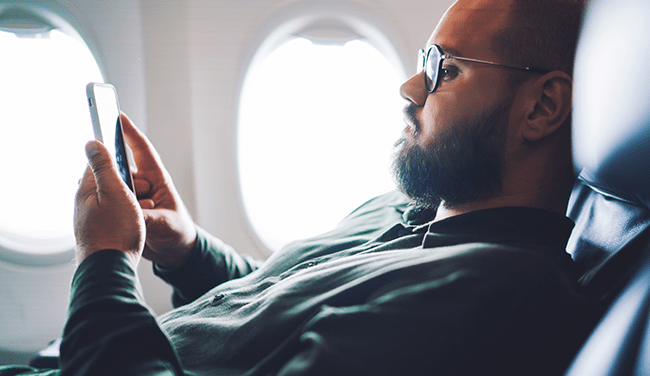Bluetooth Low Energy (BLE)-enabled medical devices meet patients where they are to provide high-quality care – even in less-than-ideal environments.
As a medical device manufacturer, you can’t control where and when patients use your device. Which is why Orthogonal has identified the many surprisingly ordinary edge cases that may impact your device’s BLE functionality. By preparing for these edge cases, you can optimize the usability and reliability of your connected medical device system.
This article will describe some of the everyday scenarios from Orthogonal’s edge case library. If you’d like to hear how we solve these edge cases, register for our upcoming webinar on August 16th, 2023!
Low Battery & Low Power Mode


Alice has had a busy day. She left the house with her phone’s battery at 75%, but after running errands for hours, the battery has drained to just 20%. Alice is still 45 minutes away from home and needs to make her phone’s battery last, so when her phone suggests it enter Low Power Mode, she readily accepts.
Unbeknownst to Alice, her continuous glucose monitor app, running in the background of her phone, just had its processing power taken away by her phone’s operating system.
An app is considered to be running in the background on a smartphone if it’s turned on but is not the app currently open on a user’s screen. Normally, a medical device app running in the background can be programmed to wake up on its own at specific times, gather data from a peripheral device over BLE and send that data wirelessly to the cloud. But Low Power Mode turns off background app processing on the smartphone, meaning that the app can no longer wake itself up to perform those functions.
How do you ensure your connected medical device is working correctly when its companion app is effectively turned off? And what happens to the connected device system if the patient doesn’t recharge their phone before the battery depletes entirely?
Airplane Mode


Ben is boarding his flight from LAX to Dallas-Fort Worth. A seasoned traveler, Ben stores his luggage in the overhead compartment, disinfects his seat and straps on his seatbelt. He even remembers to put his personal smartphone into Airplane Mode before a flight attendant has to ask.
Airplane Mode doesn’t prevent Ben’s cardiac monitoring app from retrieving data over BLE from his implanted cardiac device. But the app can’t connect through Wi-Fi or cellular internet connection to upload that data to the cloud until his plane lands.
Should data from the implanted device be stored on the phone until it can be sent to the cloud? If so, for how long? How will that data be encrypted while it sits on the phone? And what happens if the implantable device relies on AI algorithms in the cloud to analyze the data and take specific actions, but during the flight that data can’t get to the cloud and the analysis can’t be sent back to the device?
Device out of Range


Carly has just begun a treatment session with her external nerve stimulator, controlled over BLE from a companion smartphone app. But her daughter took a tumble off her bike, all the way down the street. Carly rushes down the street to help her daughter, and in her haste leaves her smartphone behind. With her phone and device hardware so far apart, the BLE connection is lost and the treatment is interrupted.
What protocols are in place for a loss of a Bluetooth connection during the nerve stimulation treatment? What is the effect on Carly’s body of an interrupted treatment session? And how does the smartphone app re-establish BLE communication and proceed with the treatment as she walks back to her house and that connection comes back online?
Polluted Radio Spectrum Environment


Duncan is in the waiting room of his doctor’s office. His doctor wanted to discuss recent readings from his connected implantable cardiovascular device. While waiting, Duncan accidentally turns off Bluetooth on his phone. He switches it back on and tries to find his device again, but the waiting room is full of similar devices from other cardiac patients, all advertising their BLE connectivity.
When many devices are advertising Bluetooth at once, it creates a polluted radio wave environment that can impact device discovery and connection setup.1 How do you prevent the smartphone app from being overloaded with so many Bluetooth connections available in the air? How do you ensure that your patients connect their smartphone to the right device? And what happens if one patient’s implantable device is accidentally connected to another patient’s smartphone app?
– – –
Looking to solve the biggest BLE challenges for your connected medical device? Orthogonal and MedSec’s joint Bluetooth Low Energy for Medical Devices Webinar Series shares best practices for the successful implementation of Bluetooth for connected medical device systems. Register to attend an upcoming webinar or join the mailing list for relevant content sent straight to your inbox.
- SEO Powered Content & PR Distribution. Get Amplified Today.
- PlatoData.Network Vertical Generative Ai. Empower Yourself. Access Here.
- PlatoAiStream. Web3 Intelligence. Knowledge Amplified. Access Here.
- PlatoESG. Automotive / EVs, Carbon, CleanTech, Energy, Environment, Solar, Waste Management. Access Here.
- BlockOffsets. Modernizing Environmental Offset Ownership. Access Here.
- Source: https://orthogonal.io/insights/bluetooth/optimizing-ble-medical-devices-identifying-edge-cases/



